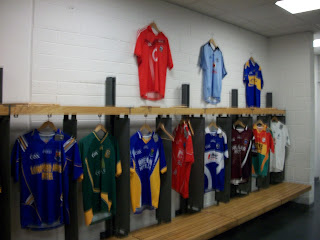Our 10:38 train arrived as scheduled (enough time to figure out tickets), and we set off for Howth. The ride was smooth, and took us across the Liffey and through the suburbs of Dublin. After a short time, we could see the Irish Sea on both sides of the car, and then arrived at the last DART stop. The station was engulfed by an expensive restaurant named The Bloody Stream, and flanked by a small open-air market. With many in the group starving for lack of breakfast, we visited the the Waffle Cafe stand. Despite the name and the advertisements for Belgian Waffles, the owner informed us that he was only able to make crepes.
After those still needing breakfast had satisfied their stomachs with a nutella crepe, a ham-and-cheese crepe, a burger, and a hot dog (a different stand) we left the space heater and made for the tourism office. Friends of ours had visited Howth the weekend before, and recommended the office for its free map and hiking trail information. To reach the office, we walked along the street that stretched to the harbor on one side and restaurants and fish markets on the other. As we reached the end of the West Pier, we came upon the entrance to the harbor, with a lighthouse on the opposite side, and the tourism office to our left.
 |
| On the West Pier Sea Wall |
Along the road that scaled the cliffs, we first noticed that each house displayed a placard to name the building. Several were in Irish, most were clever, and only one was named Cliff Cottage. The narrow road took us past a former childhood home of poet W.B. Yeats, and at its end, to the start of the Fingal Trail, cliff walk. Several signs at the start of the trail warned visitors to be wary of dangerous paths that clung to the cliff, and banned the use of bicycles and horses.
The path winds around the Eastern and Southern sides of the peninsula, though with roads, it is possible to walk around the whole of Howth. Each turn brought us another stunning vista, with views of the path as it wrapped around the elevation unseen in Dublin as well as the Irish Sea that extended to the horizon. Ignoring the warnings of the signs, we stopped at several points to leave the path and stand out on narrow outcroppings for plenty of photographs. Nevertheless, we, and the several Italian families that followed the trail with us, made it to the intersection with the Upper Cliff Path without incident.
 |
| View of Baily Lighthouse from the Fingal Trail |
Once at the summit, we walked in the direction of Balscadoen road, and enjoyed additional sights of the Irish Sea. The Upper Path was much wider than its lower counterpart, and at least one person ignored the posted signs, as hoof prints were clear in the mud that crisscrossed the trail. Following the much shorter trip than the full walk around the peninsula, and only after passing a out-of-place palm trees, we arrived at the link with Thormanby Road. We then followed it through the old Howth Village and down to the Harbour.
Despite our insistence on purchasing local fish and chips, the wait at the one affordable restaurant and the cold that would us after visiting the even cheaper take-away one, soon broke the resolve of many in the group. However, they did not succumb to the allure of freshly cooked pizza and wraps at a second market without passing by the same shops several times in vain to find a student-priced venue. By the end, only John and I achieved the goal of eating some local fish, by purchasing an enormous fish and chips box from the Tram Chowder stand (shaped as a miniature box car) situated along West Pier. As a sign of the internationalism of Ireland, the shop was owned by a Brazilian immigrant.
 |
| Delicious Fish and Chips for 8 Euro |
With 45 minutes before the next departure, we decided to walk in the opposite direction of the harbor to see Howth Castle. The building was constructed following the Norman Conquest to house the Earl of Howth. Since then, the St. Lawrence family has lived in the structure, making it one of the oldest continuously inhabited buildings in Ireland (since 1180). Even so, the material wealth of the current owners is not sufficient to maintain the structure as several towers, gates, and windows are boarded, broken, and dilapidated. Still, the main keep is intact, and as a private residence, is not open to visitors. So, we snapped a few pictures, and headed back to the DART Station.
 |
| Front of Howth Castle |
By the time we arrived at Pearse Street around 5pm, everyone had warmed up, but were ready to return home to nap and relax.
Things that are Different: there are no folders
Stores that are Not: Eddie (Johnny) Rocket's





















